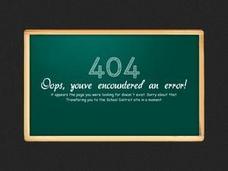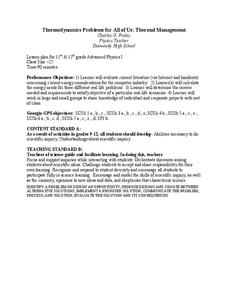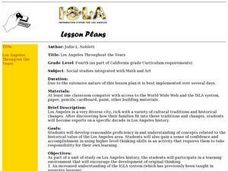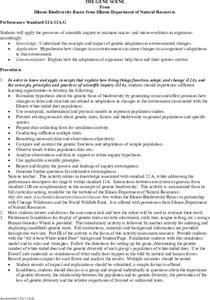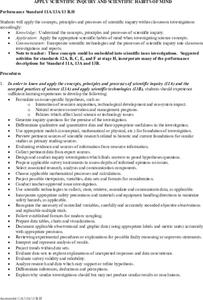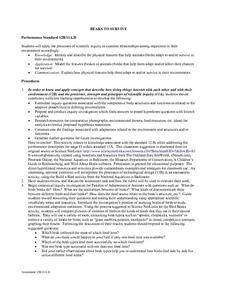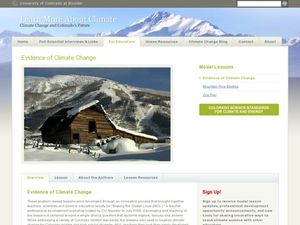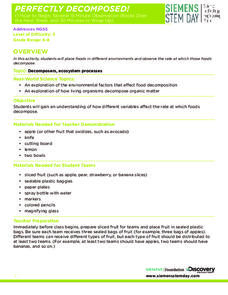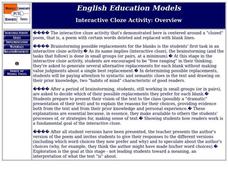Curated OER
Science: Trouble in the Troposphere
Students research a NASA Website and record information about an assigned city's tropospheric ozone residual monthly climate. In groups, they graph the information for the past year. They form new groups and compare their city's...
Curated OER
Great River Bend Adventure
Students use their imagination. They discuss the 4 C's of teamwork: Concentration, Communications, Coomperation, and Consideration. Students discuss the safety guidelines of the project. They complete a rope maze. The group walks...
Curated OER
Fossils-Where Should We Place Archaeopteryx?
High schoolers explore an interactive computer activity that provides the opportunity to look at features of various groups of animals and determine where an extinct organism might be classified.
Curated OER
Global Warming: The Greenhouse Effect Visualizer
Students work in small groups to study the various aspects of global weather and discuss the possibility of a Greenhouse Effect.
Curated OER
Population Limits
Middle schoolers gather information on China's government controlled population limit policy, discuss the policy with their peers, mathematically model different policies, and decide as a class on the best policy.
Curated OER
Have You Ever Wondered?
Learners use their personal knowledge and the Internet to discover where and how spiders live. In groups, they discuss their experiences with spiders and how their lives differ from other insects. They use new vocabulary to discuss their...
Curated OER
Biology: Creative Cells
Students use various snacks to make large models of human cells. Items such as gumballs, gummy worms, and jelly beans represent the nucleus, golgi bodies, and mitochondria. As each piece of candy is added, the teacher explains what it...
Curated OER
Apply Technological Design and Scientific Habits of Mind
High schoolers are introduced to the principles involved with technological design. In groups, they use the Internet to research an important historical innovation and how it changed the world. They discover the barriers that were...
Curated OER
Nebraska: Using Pictures
Students create a scrapbook about Nebraska history focusing on Post Office murals. They choose their favorite murals and write a story to go along with the mural. In groups, students present their murals to the class and visit the...
Curated OER
Where Should We Place Archaeopteryx?
Learners classify Archaeopteryx using pictures of actual fossils and scientist representations of how the animal might have looked. They compare Archaeopteryx's characteristics to those of the five extant vertebrate groups to...
Curated OER
Active Reading: Finding a Conversation Voice
Students practice reading for comprehension and understanding. In groups, students read, out loud, using a conversation voice. They predict and discuss the story as it unfolds.
Curated OER
Communication Collaboration with Technology Tools
Introduce your class to technology tools that allow them to communicate with other classes. Using the Internet, they will send pictures of their class along with the school website to another class. To end the lesson, they practice using...
Curated OER
Thermodynamics Problems for All of Us: Thermal Management
Learners evaluate current literature on the Internet and in handouts about the energy considerations for the computer industry and calculate energy needs for real life problems. Working in groups, they present the problem they...
Curated OER
Los Angeles Throughout the Years
In groups, 4th graders are given a recent decade to focus on and its impact on Los Angeles and to see how the city has changed over time.
Curated OER
The Gene Scene
Learners investigate the concepts of micro and macro evolution. They also research the effects of mutations in the process of genetic adaptation to different environments. They develop a hypothesis of how the environment can influence...
Curated OER
Apply Scientific Inquiry and Scientific Habits of Mind
Students review the components of the scientific inquiry method. In groups, they develop hypothesis on the issue given to them by their teacher and inquiry questions. They state the data in terms of qualitative and quantitative data. ...
Curated OER
Beaks To Survive
Students discuss and identify the types of adaptations that are made by different organisms in order for them to survive. In groups, they describe the features of beaks and discuss how it affects their chances for survival. They share...
Curated OER
Our Landfill Future
Students use the internet to research articles on garbage, landfills and the environment. In groups, they identify ways to conserve or recycle materials found in landfills and determine the future of a local landfill. They share their...
Curated OER
Hands on Habitat
Learners teach others about habitats. In this Science lesson, students use a Science Log to record data about a habitat for research. Learners analyze the data and construct an eco-chamber. Students share what they have found with other...
Curated OER
Evidence of Climate Change
Sixth graders examine climate change in the state of Colorado. In this climate lesson, 6th graders watch 2 video clips regarding the topic and research the subtopics- snow pack, precipitation, temperature, forest fires, river flow,...
Discovery Education
Perfectly Decomposed!
We all know someone who won't eat the banana with a brown spot, the grape with a dimple, and the apple with a bruise. Scholars use different fruits to explore what happens when fruits really start to decompose. They set up an experiment...
Curated OER
Youth voters and election turnout
Young scholars investigate why 18- to 24- year-olds have a low turnout at the polls. Students develop a plan to encourage young Americans to vote, or write a persuasive essay telling why they should vote.
Curated OER
Cloze Activity
Students brainstorm possible replacements for blanks in a cloze activity. They work in groups to decide which of their possible replacements are prefered for each blank. They then prepare to present their ideas of the text to the class...
Curated OER
Meteor Monitor
Student's measure sporadic meteor activity. In this physics and astronomy lesson plan, 11th graders construct a dipole antennae, and build, test and wire a full wave diode rectifier between the dipole antenna and the laptop.




